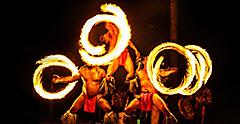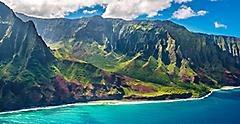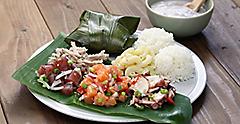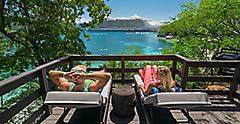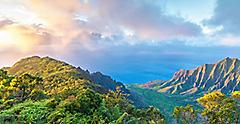Hawaiian Traditions: A Deep Dive Into Luau History
The Best Way To Experience Hawaiian Culture
By Melissa Alvarado Sierra | Published on August 16, 2023
During my visit to the Hawaiian islands, I knew I could not leave without attending a luau. Everyone I knew recommended making it the number one item on my Hawaii vacation bucket list, and for good reason. These exciting parties are a fun way to get to know Hawaii, though I wanted to know more about luau history before I experienced one for myself.
What Is A Hawaiian Luau?
First things first: What is a luau? Luaus are traditional parties that feature live mele (songs), hula (dance) and mea 'ai (food). These cultural performances and dishes are from Hawaii, but also from greater Polynesia. It's a grand event and an important part of Hawaiian culture and life, a time for locals to celebrate family milestones. Luaus are also held to honor guests and visitors, which is why public luaus take place all across the Hawaiian islands. I joined this spectacular attraction and had some of the most delicious Hawaiian cuisine, sipped on local drinks under the stars and watched authentic hula performances that told important stories of these paradisiacal islands.
To learn more Hawaiian luau history, I visited the Polynesian Cultural Center in Oahu and then the Smith Family Garden Luau in Kauai, though there are popular luaus on each island. Some of the best luaus in Hawaii include Germaine's Luau and Chief's Luau in Oahu, Smith Family Garden Luau and Luau Kalamaku in Kauai, The Myths of Maui and Old Lahaina Luau in Maui, and Island Breeze Luau and Hawaii Loa in Hawaii Island.
When The Feast Started
In ancient Hawaii, the luau was called "aha'aina" and it was deeply religious and restrictive, prohibiting men and women from eating together. Traditional Hawaiian foods at the time, like moi, pork and bananas, were only eaten by chiefs and the King of ancient Hawaii, mainly because these foods symbolized virtues the person consuming them hoped to attain. King Kamehameha II abolished the Kapu (taboo) system in 1819 and commemorated this trailblazing decision with a feast that included women. With this change, he revolutionized the tradition and ended the religious influence on Hawaiian celebrations. This, in turn, gave way to the modern luau.
In the Hawaiian language, the word luau translates to "taro plant," and its leaves are baked in coconut milk to accompany different dishes, including squid and chicken, both staples of a Hawaiian feast. Originally, the food was served on the floor and people ate it from lauhalas (large woven mats) with their hands. Dishes were interestingly called by the number of fingers needed to grab them: "three-finger," "two-finger," or "one-finger poi," for example. Dishes were surrounded by elaborate centerpieces made of eye-catching tropical flowers, fruits, ferns and leaves. These were large and extravagant events, many attended by hundreds, sometimes thousands, of people, depending on the celebration. One of the largest luaus was held by King Kamehameha III in 1847 when he hosted thousands of guests with a celebration that required close to 300 pigs, 2,200 coconuts, 4,000 taro tops and more than 5,000 fish.
The Legacy Of Luaus Throughout Hawaii
In the 1850s, the luau slowly evolved from a celebration of food for some to a celebration of food, music and dance for everyone. This new version was less focused on tradition and religious ceremonies, and more on celebrating special occasions and having a good time with close people. From then on, luaus stayed under the radar and mostly took place within the local Hawaiian communities.
In 1946, Don Beach, an American adventurer and "founding father" of tiki culture, threw a birthday party at his Encino, California, plantation for model and actress Anita Colby. According to Life magazine, the party's theme was something very close to a luau. Beach had traveled extensively throughout the Polynesian islands and Hawaii and had been fascinated by the way people celebrated milestones. Those attending his party shared that the venue featured banana trees, palms, suckling pig and coconut-stuffed salmon, as well as dancers in sarongs. They all ate on the floor and drank delicious concoctions out of hollowed pineapples, instantly falling in love with the island theme. But it wasn't until the 1960s, when Hawaiian and surf culture became hugely popular, that the luau gained momentum, both as a tourist attraction and a Hawaiian export.
Today, a luau is an unmissable experience to have when visiting the Hawaiian islands on a cruise vacation. During my visit, I understood that this is a festivity the whole family can enjoy and where you get to try traditional Hawaiian food, admire music and dance, and become part of a treasured local tradition. The modern luau is a celebration of life and a manifestation of the spirit of Aloha in the form of a cultural, spiritual and social event, where you also have the honor of wearing a traditional Hawaiian lei. This made for some epic photos I had to share on social media.
I also realized that luaus have transcended the Hawaiian islands, reaching all corners of the globe and spreading goodwill, fun, sharing and that quintessential spirit of Aloha. While these modern luaus may still include some traditional Hawaiian foods, hula dancers, mai tais and leis, I know the most authentic way to experience a luau (and luau history) is on the sacred grounds of Hawaii, where the tradition has profound meaning to the local people. I was happy to experience one of these in mesmerizing Kauai, known as the Garden Island.
Proof's In The Coconut Pudding
One of the main draws of a luau is the food, and I was particularly excited about trying new dishes that are reflective of Hawaiian culture and history. Luaus new and ancient focused on one particular aspect: the cherishing of good food. Some luaus today serve plated meals, though most are presented in the form of a buffet or "ohana," which is the family-style sharing of food. The modern Hawaiian luau mirrors the state's multicultural society and because of this, you can expect the traditional luau foods to vary depending on where you go. This also applies to family luaus — they are as varied as the families that prepare them. I attended a visitor luau, which served dishes like pork, rice and fresh fruits.
What To Expect When You Attend A Luau In Hawaii
A Hawaiian luau is an opportunity to learn about a beloved local tradition and share that experience with friends and family. It's also a time to celebrate life and your incredible Hawaiian vacation. If you're wondering what to wear at a luau in Hawaii, make sure to dress casually and comfortably as you dance the night away. Luaus are informal events that take place outdoors where you will typically sit to eat on the floor, so stretchy fabrics and breezy layers are recommended. Bright colors and floral prints will definitely help you dress the part! Upon arrival, you will most likely be greeted with a kukui nut or flower lei, these are a sign of affection and being welcomed. You should always accept the lei as a sign of respect.
From start to finish, a Hawaiian luau is a performance. Before eating, there will be an imu ceremony. The hosts will remove layers of cloth and leaves from the oven to reveal the food you will be eating later at the buffet. After the feast, the dancing commences! Talented performers will dance in the traditional style, such as the hula, to Hawaiian and Polynesian music. Sometimes, luaus even end with a dazzling Samoan fire dance, marking the end of an incredible experience on your Hawaiian vacation.
Get Royal Deals, Sign Up Today
Related Articles
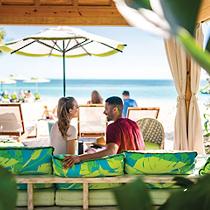
Vacation Gift Ideas: Give the Gift of Cruising | Royal Caribbean Cruises
READ MORE
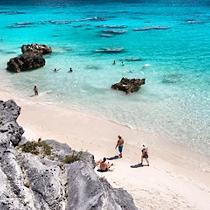
The Best Time to Visit Bermuda | Royal Caribbean Cruises
READ MORE
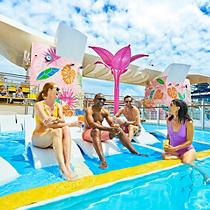
Girls and guys weekend trip ideas: How to plan a cruise getaway | Royal Caribbean Cruises
READ MORE
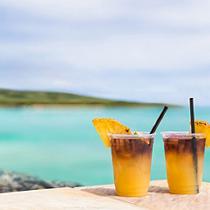
[Infographic] What to Drink at Perfect Day at CocoCay
READ MORE

